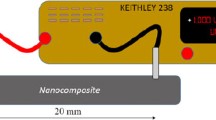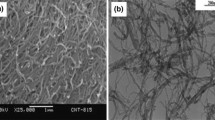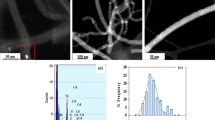Abstract
In this work, it is reported the necessity to characterize the raw carbon materials before their application in composite electrodes based on multiwall carbon nanotubes (MWCNTs) dispersed in epoxy resin for the development of improved amperometric sensors. These sensors must contain an optimum MWCNT/epoxy ratio for their best electroanalytical response. The main drawback in MWCNTs composite materials resides in the lack of homogeneity of the different commercial nanotubes largely due to different impurities content, as well as dispersion in their diameter/length ratio and state of aggregation. The optimal composite electrode composition takes into account the high electrode sensitivity, low limit of detection, fast response, and electroanalytical reproducibility. These features depend on carbon nanotube physical properties as the diameter. Three different commercial carbon nanotubes with different diameters were characterized by transmission electron microscopy and the results were significantly different from the ones provided by the manufacturers. Then, the three MWCNTs were used for the MWCNT/epoxy sensors construction. After an accurate electrochemical characterization by cyclic voltammetry and electrochemical impedance spectroscopy, they were employed as working electrodes using ascorbic acid as a reference analyte. Percolation theory was applied in order to verify the electrochemical results. It is demonstrated that the optimum interval load of raw carbon material in the optimized-composite electrodes closely depends on the MWCNTs diameter, needing 5 % in carbon content for the narrowest MWCNTs containing composite electrodes versus 12 % for the widest MWCNTs.






Similar content being viewed by others
References
Céspedes F, Martinez-Fàbregas E, Alegret S (1996) New materials for electrochemical sensing I. Rigid conducting composites. Trends Anal Chem 15:296–304
Zhao Q, Gan Z, Zhuang Q (2002) Electrochemical sensors based on carbon nanotubes. Electroanalysis 14:1609–1613
Vashist SK, Zheng D, Al-Rubeaan K, Luong JHT, Sheu F-S (2011) Advances in carbon nanotube based electrochemical sensors for bioanalytical applications. Biotechnol Adv 29:169–188
Yang X, Feng B, He XL, Li FP, Ding YL, Fei JJ (2013) Carbon nanomaterial based electrochemical sensors for biogenic amines. Microchim Acta 180:935–956
Pumera M, Merkoçi A, Alegret S (2006) Carbon nanotube-epoxy composites for electrochemical sensing. Sensors Actuat B: Chem 113:617–622
Švancara I, Vytřas K, Barek J, Zima J (2001) Carbon paste electrodes in modern electroanalysis. Crit Rev Anal Chem 31:311–345
Zima J, Švancara I, Barek J, Vytřas K (2009) Recent advances in electroanalysis of organic compounds at carbon paste electrodes. Crit Rev Anal Chem 39:204–227
Navratil T, Barek J (2009) Analytical applications of composite solid electrodes. Crit Rev Anal Chem 39:131–147
Alegret S, Morales A, Céspedes F et al (1996) Hydrogen peroxide amperometric biosensor based on a peroxidase-graphite-epoxy biocomposite. Anal Chim Acta 332:131–138
Lermo A, Fabiano S, Hernández S et al (2009) Immunoassay for folic acid detection in vitamin-fortified milk based on electrochemical magneto sensors. Biosens Bioelectron 24:2057–2063
Orozco J, Fernández-Sánchez C, Mendoza E, Baeza M, Céspedes F, Jiménez-Jorquera C (2008) Composite planar electrode for sensing electrochemical oxygen demand. Anal Chim Acta 607:176–182
Wang D, Li Z-C, Chen L (2006) Templated synthesis of single-walled carbon nanotube and metal nanoparticle assemblies in solution. J Am Chem Soc 128:15078–15079
Gao C, Li W, Morimoto H, Nagaoka Y, Maekawa T (2006) Magnetic carbon nanotubes: synthesis by electrostatic self-assembly approach and application in biomanipulations. J Phys Chem B 110:7213–7220
Balasubramanian K, Burghard M (2005) Chemically functionalized carbon nanotubes. Small 1:180–192
Guadagno L, De Vivo B, Di Bartolomeo A et al (2011) Effect of functionalization on the thermo-mechanical and electrical behavior of multi-wall carbon nanotube/epoxy composites. Carbon 49:1919–1930
Valentini F, Amine A, Orlanducci S, Terranova ML, Palleschi G (2003) Carbon nanotube purification: preparation and characterization of carbon nanotube paste electrodes. Anal Chem 75:5413–5421
Shi J, Wang Z, Li H-l (2007) Electrochemical fabrication of polyaniline/multi-walled carbon nanotube composite films for electrooxidation of methanol. J mater sci 42:539–544
Solanki PR, Kaushik A, Ansari AA, Tiwari A, Malhotra B (2009) Multi-walled carbon nanotubes/sol-gel-derived silica/chitosan nanobiocomposite for total cholesterol sensor. Sensors Actuat B: Chem 137:727–735
Noonan M (2005) Glucose biosensor based on carbon nanotube epoxy composites. Nanosci Nanotechnol 5:1694–1698
Liu M, Wen Y, Xu J et al (2011) An amperometric biosensor based on ascorbate oxidase immobilized in poly(3,4-ethylenedioxythiophene)/multi-walled carbon nanotubes composite films for the determination of L-ascorbic acid. Anal Sci 27:477–482
Liu Y, Su Z, Zhang Y et al (2013) Amperometric determination of ascorbic acid using multiwalled carbon nanotube-thiolated polyaniline composite modified glassy carbon electrode. J Electroanal Chem 709:19–25
Olivé-Monllau R, Baeza M, Bartrolí J, Céspedes F (2009) Novel amperometric sensor based on rigidi near-percolation composite. Electroanalysis 21:931–938
Shobha Jeykumari DR, Ramaprabhu S, Sriman Narayanan S (2007) A thionine functionalized multiwalled carbon nanotube modified electrode for the determination of hydrogen peroxide. Carbon 45:1340–1353
Liang M, Jin F, Liu R et al (2013) Enhanced electrochemical detection performance of multiwall carbon nanotubes functionalized by aspartame. J Mater Sci 48:5624–5632
McCreery RL (2008) Advanced carbon electrode materials for molecular electrochemistry. Chem Rev 108:2646–2687
Olivé-Monllau R, Esplandiu MJ, Bartrolí J, Baeza M, Céspedes F (2010) Strategies for the optimization of carbon nanotube/polymer ratio in composite materials: applications as voltammetric sensors. Sensors Actuat B: Chem 146:353–360
Arrigan DW (2004) Nanoelectrodes, nanoelectrode arrays and their applications. Analyst 129:1157–1165
Weisshaar DE, Tallman DE (1983) Chronoamperometric response at carbon-based composite electrodes. Anal Chem 55:1146–1151
Castillo FY, Socher R, Krause B et al (2011) Electrical, mechanical, and glass transition behavior of polycarbonate-based nanocomposites with different multi-walled carbon nanotubes. Polymer 52:3835–3845
Martin C, Sandler J, Shaffer M et al (2004) Formation of percolating networks in multi-wall carbon -nanotube-epoxy composites. Composites Sci Technol 64:2309–2316
Li J, Ma PC, Chow WS, To CK, Tang BZ, Kim JK (2007) Correlations between percolation threshold, dispersion state, and aspect ratio of carbon nanotubes. Adv Funct Mater 17:3207–3215
Jiang M-J, Dang Z-M, Xu H-P, Yao S-H, Bai J (2007) Effect of aspect ratio of multiwall carbon nanotubes on resistance-pressure sensitivity of rubber nanocomposites. Appl Phys Lett 91:072907-1–072907-3
Pegel S, Pötschke P, Petzold G, Alig I, Dudkin SM, Lellinger D (2008) Dispersion, agglomeration, and network formation of multiwalled carbon nanotubes in polycarbonate melts. Polymer 49:974–984
Song W, Windle AH (2005) Isotropic-nematic phase transition of dispersions of multiwall carbon nanotubes. Macromolecules 38:6181–6188
Krause B, Boldt R, Pötschke P (2011) A method for determination of length distributions of multiwalled carbon nanotubes before and after melt processing. Carbon 49:1243–1247
Rosca ID, Hoa SV (2009) Higly conductive multiwall carbon nanotube and epoxy composites produced by three-roll milling. Carbon 47:1958–1968
Chen Z, Appenzeller J, Knoch J, Lin Y-m, Avouris P (2005) The role of metal-nanotube contact in the performance of carbon nanotube field-effect transistors. Nano Lett 5:1497–1502
Krause B, Villmow T, Boldt R, Mende M, Petzold G, Pötschke P (2011) Influence of dry grinding in a ball mill on the length of multiwalled carbon nanotubes and their dispersion and percolation behaviour in melt mixed polycarbonate composites. Composites Scie Technol 71:1145–1153
Zhao H, O’Hare D (2008) Characterization and Modeling of Conducting Composite Electrodes. J Phys Chem C 112:9351–9357
Carabineiro S, Pereira M, Nunes-Pereira J et al (2012) The effect of nanotube surface oxidation on the electrical properties of multiwall carbon nanotube/poly (vinylidene fluoride) composites. J Mater Sci 47:8103–8111
Cadek M, Coleman J, Ryan K et al (2004) Reinforcement of polymers with carbon nanotubes: the role of nanotube surface area. Nano Lett 4:353–356
Mansfield E, Kar A, Hooker SA (2010) Applications of TGA in quality control of SWCNTs. Anal Bioanal Chem 396:1071–1077
Pang LS, Saxby JD, Chatfield SP (1993) Thermogravimetric analysis of carbon nanotubes and nanoparticles. J Phys Chem 97:6941–6942
Bard AJ, Faulkner LR (1980) Electrochemical methods: fundamentals and applications. Wiley, New York
Pacios M, Del Valle M, Bartroli J, Esplandiu M (2008) Electrochemical behavior of rigid carbon nanotube composite electrodes. J Electroanal Chem 619:117–124
Acknowledgements
We are sincerely grateful to all our associates cited throughout the text for making this publication possible. J. Muñoz thanks Universitat Autònoma de Barcelona (UAB) for the award of PIF studentship.
Author information
Authors and Affiliations
Corresponding author
Rights and permissions
About this article
Cite this article
Muñoz, J., Bartrolí, J., Céspedes, F. et al. Influence of raw carbon nanotubes diameter for the optimization of the load composition ratio in epoxy amperometric composite sensors. J Mater Sci 50, 652–661 (2015). https://doi.org/10.1007/s10853-014-8624-2
Received:
Accepted:
Published:
Issue Date:
DOI: https://doi.org/10.1007/s10853-014-8624-2




